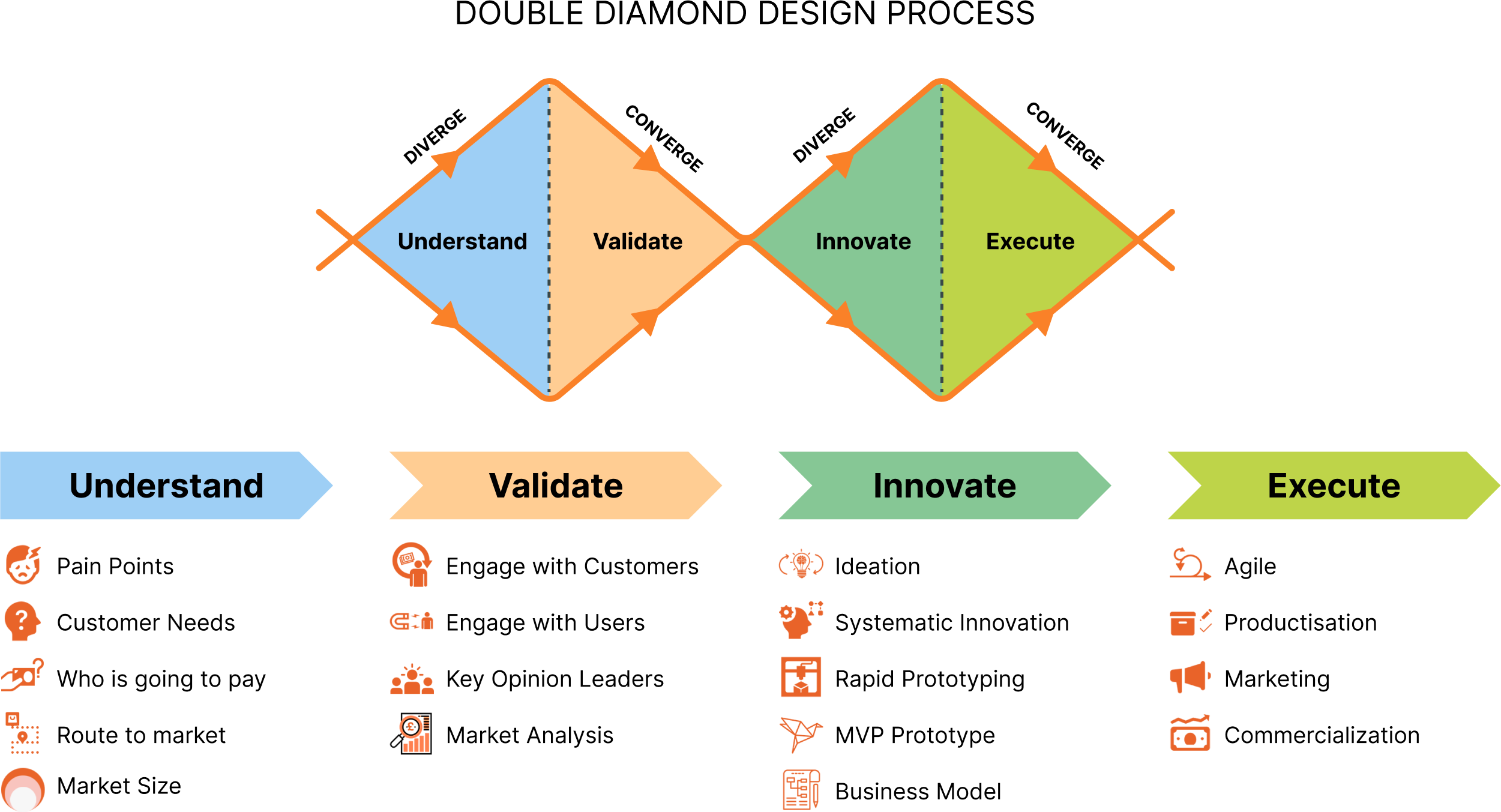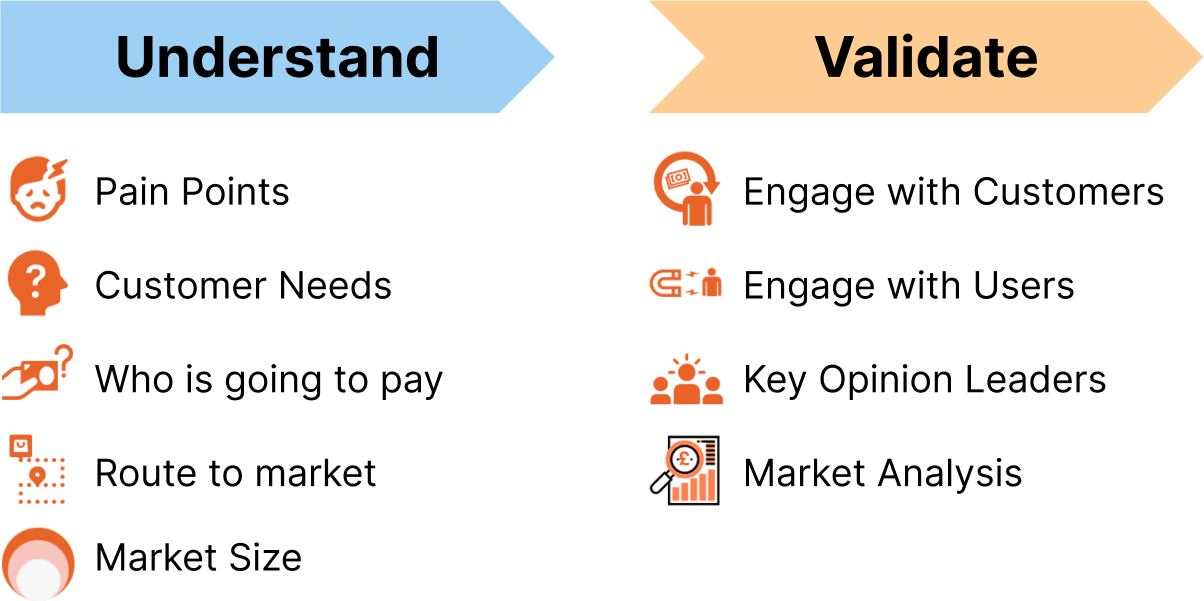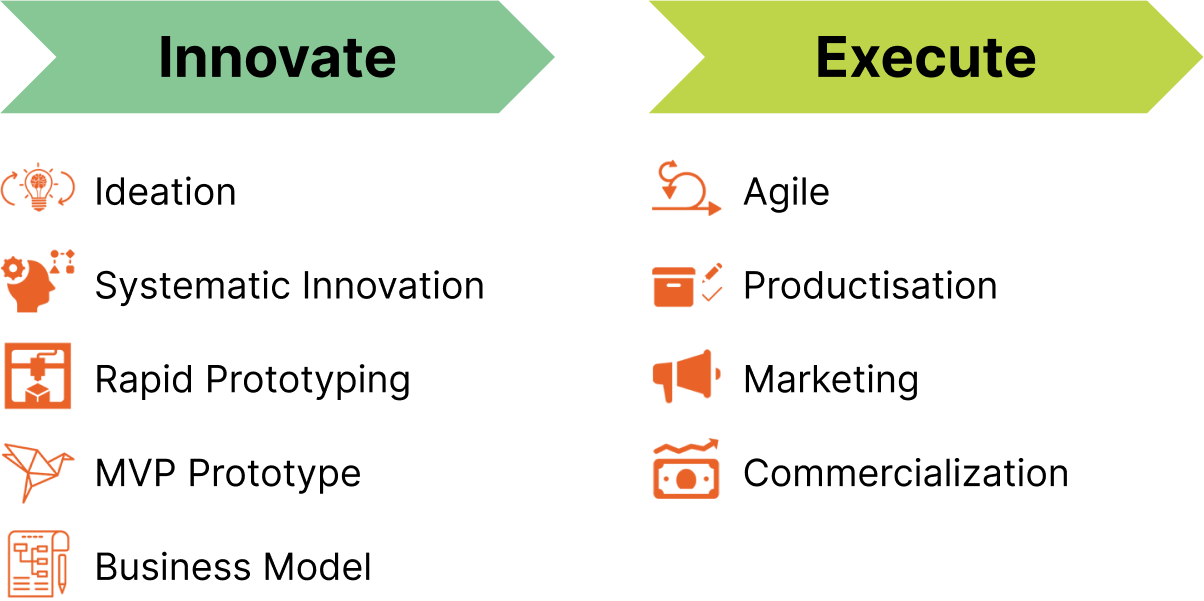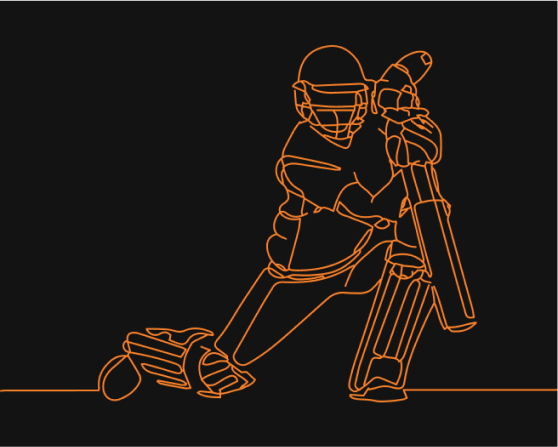Our Approach
HOW WE WORK
“Design is really an act of communication, which means having a deep understanding of the person with whom the designer is communicating.”
~ Don Norman, Author of The Design of Everyday Things
Systematic Innovation: Double Diamond
Popularised by the British Design Council in 2005, the Double Diamond process breaks up the designing of a product into four phases that we call: understand, validate, innovate and execute. This method places equal emphasis on the problem as well as the solution, encouraging more user-centred design.
Here, the design team moves from one phase to the next by alternately diverging and converging ideas and thinking. In the divergent phases, we brainstorm and emphasise creativity. Then we converge viable solutions till we find the right answer to each unique problem.

Systematic Innovation: Double Diamond


Popularised by the British Design Council in 2005, the Double Diamond process breaks up the designing of a product into four phases that we call: understand, validate, innovate and execute. This method places equal emphasis on the problem as well as the solution, encouraging more user-centred design.
Here, the design team moves from one phase to the next by alternately diverging and converging ideas and thinking. In the divergent phases, we brainstorm and emphasise creativity. Then we converge viable solutions till we find the right answer to each unique problem.

Positioning & Timing
Simon Sinek, author and motivational speaker, famously said, “From order comes progress. From chaos comes innovation.” While chaos would be an apt descriptor for the state of our labs on occasion(!), it is equally true that we innovate with a strong dose of pragmatism.
We believe that anything we create has to be commercially viable and useful to actual people in the real world. And for this, positioning and timing are key.
Businesses need to position themselves as well as their product(s) with as much precision as a batsman would line up for the perfect cover drive. Taking the cricket analogy further, we understand that timing too can make or break your attempt, so we leverage up and coming technology just as the market is opening up to the possibilities.
To ensure Esquare can meet these lofty goals, we are a vertically-aligned business, i.e. we take direct ownership of the innovation process, with all our components either sourced in-house or in direct partnership. In this way we control for quality of process as well as product.
Positioning & Timing

Simon Sinek, author and motivational speaker, famously said, “From order comes progress. From chaos comes innovation.” While chaos would be an apt descriptor for the state of our labs on occasion(!), it is equally true that we innovate with a strong dose of pragmatism.
We believe that anything we create has to be commercially viable and useful to actual people in the real world. And for this, positioning and timing are key.
Businesses need to position themselves as well as their product(s) with as much precision as a batsman would line up for the perfect cover drive. Taking the cricket analogy further, we understand that timing too can make or break your attempt, so we leverage up and coming technology just as the market is opening up to the possibilities.
To ensure Esquare can meet these lofty goals, we are a vertically-aligned business, i.e. we take direct ownership of the innovation process, with all our components either sourced in-house or in direct partnership. In this way we control for quality of process as well as product.
Human-Centred Design:
Nudge Display
An innovative approach to designing solutions, Human-Centred Design (HCD) prioritises the needs, preferences, and experiences of people, ensuring that every solution is tailor-made to enhance access, user satisfaction and usability.
Esquare Innovations practices HCD by simplifying tech. Through empathetic engagement with and detailed research into the requirements of various stakeholders, we develop cost-optimised, user-friendly products, services and systems that are intuitive, accessible and effective.
We recently innovated to bring one such revolutionary idea to market: Nudge Display.

Human-Centred Design:
Nudge Display

An innovative approach to designing solutions, Human-Centred Design (HCD) prioritises the needs, preferences, and experiences of people, ensuring that every solution is tailor-made to enhance access, user satisfaction and usability.
Esquare Innovations practices HCD by simplifying tech. Through empathetic engagement with and detailed research into the requirements of various stakeholders, we develop cost-optimised, user-friendly products, services and systems that are intuitive, accessible and effective.
We recently innovated to bring one such revolutionary idea to market: Nudge Display.
Based on the principles of Nudge Theory as described by Richard Thaler and Cass Sunstein, this messaging platform is built on the idea that when users are offered relevant information at strategic moments, they make wiser choices. By shaping the decision-making environment, one can positively ‘nudge’ people into choices that align with their individual as well as communal goals.
Nudging is also an extremely accessible approach: it allows individuals to make their own choices, at their own pace, dependent on their personal circumstances. Applying these best practices from modern behavioural research, we designed Nudge Display to be an ethical, accessible and effective communication hub for public service, health, safety, promotions and much more.
Fail-Fast Concept
In technology, Fail-Fast (sometimes called Learn Fast) pushes for quick decision-making and assessments of products and strategy. By pinpointing weaknesses early and often during the creation process, a business can cut losses rather than continue to waste resources through sunk cost fallacy. This additionally prevents eventual larger losses (including to the brand and reputation) that a failed final product would incur.
A century ago, Thomas Edison was criticised for his failures. His response: “I’ve just found 10,000 ways that won’t work”. At Esquare our team does not shy away from failures because we see them as valuable learning that helps us towards finding the right solution. Focusing on the riskiest elements of each design proposal pushes us to solve the hardest problems first — and discover what won’t work very early in the process. We build on our learnings to move on to the next iteration, eventually creating a product that is commercially viable, durable and also excites us. This allows us to make faster than average advances in ideation, rapid prototyping, etc.

Fail-Fast Concept

In technology, Fail-Fast (sometimes called Learn Fast) pushes for quick decision-making and assessments of products and strategy. By pinpointing weaknesses early and often during the creation process, a business can cut losses rather than continue to waste resources through sunk cost fallacy. This additionally prevents eventual larger losses (including to the brand and reputation) that a failed final product would incur.
A century ago, Thomas Edison was criticised for his failures. His response: “I’ve just found 10,000 ways that won’t work”. At Esquare our team does not shy away from failures because we see them as valuable learning that helps us towards finding the right solution. Focusing on the riskiest elements of each design proposal pushes us to solve the hardest problems first — and discover what won’t work very early in the process. We build on our learnings to move on to the next iteration, eventually creating a product that is commercially viable, durable and also excites us. This allows us to make faster than average advances in ideation, rapid prototyping, etc.